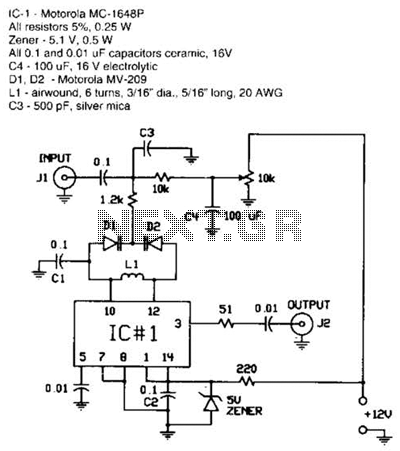
Fm Modulator Circuit

The FM modulator is constructed using a Motorola MC1648P oscillator. Two varactors, the Motorola MV-209, are employed to frequency modulate the oscillator. A 5000-ohm potentiometer is utilized to bias the varactors for optimal linearity. The output frequency, which is approximately 100 MHz, can be adjusted by altering the value of the inductor. The output frequency can fluctuate by as much as 10 MHz on either side. The output level of the modulator is -5 dBm. In this prototype, the varactor bias was set to 7.5 V for optimal linearity; however, this value may vary with different varactors.
The FM modulator circuit utilizes the Motorola MC1648P as the core oscillator component, which is known for its stability and performance in frequency modulation applications. The inclusion of two Motorola MV-209 varactors allows for effective modulation of the oscillator frequency. These varactors are semiconductor devices that exhibit a variable capacitance based on the applied reverse voltage, making them ideal for frequency modulation tasks.
The 5000-ohm potentiometer serves a crucial role in adjusting the bias voltage applied to the varactors. This adjustment is essential for achieving the best linearity in the modulation process, impacting the fidelity and quality of the transmitted signal. The output frequency of the modulator is centered around 100 MHz, a common frequency for FM transmission, and can be fine-tuned by changing the inductance value in the circuit. The design allows for a frequency deviation of up to 10 MHz in either direction, providing flexibility in tuning the desired output frequency.
The output power level of the modulator is specified at -5 dBm, indicating the strength of the signal being transmitted. This power level is a critical parameter in ensuring that the signal can be effectively received by FM receivers without excessive noise or distortion. The prototype's varactor bias of 7.5 V was determined to provide optimal performance; however, it is important to note that varying the bias voltage may be necessary when different varactors are employed, as their characteristics can differ significantly.
In summary, this FM modulator circuit is designed for efficient frequency modulation using a well-defined oscillator and varactor configuration, with adjustable parameters to optimize performance for various applications. The FM modulator is built with a Motorola MC1648P oscillator. Two varactors, Motorola MV-209, are used to frequency modulate the oscillator. The 5000- potentiometer is used to bias the varactors for best linearity. The output frequency of approximately 100 MHz can be adjusted by changing the value of the inductor. The output frequency can vary as much as 10 MHz on each side. The output level of the modulator is -5 dBm. In this prototype, the varactor bias was 7.5 V for best linearity; but this could be different with other varactors.
The FM modulator circuit utilizes the Motorola MC1648P as the core oscillator component, which is known for its stability and performance in frequency modulation applications. The inclusion of two Motorola MV-209 varactors allows for effective modulation of the oscillator frequency. These varactors are semiconductor devices that exhibit a variable capacitance based on the applied reverse voltage, making them ideal for frequency modulation tasks.
The 5000-ohm potentiometer serves a crucial role in adjusting the bias voltage applied to the varactors. This adjustment is essential for achieving the best linearity in the modulation process, impacting the fidelity and quality of the transmitted signal. The output frequency of the modulator is centered around 100 MHz, a common frequency for FM transmission, and can be fine-tuned by changing the inductance value in the circuit. The design allows for a frequency deviation of up to 10 MHz in either direction, providing flexibility in tuning the desired output frequency.
The output power level of the modulator is specified at -5 dBm, indicating the strength of the signal being transmitted. This power level is a critical parameter in ensuring that the signal can be effectively received by FM receivers without excessive noise or distortion. The prototype's varactor bias of 7.5 V was determined to provide optimal performance; however, it is important to note that varying the bias voltage may be necessary when different varactors are employed, as their characteristics can differ significantly.
In summary, this FM modulator circuit is designed for efficient frequency modulation using a well-defined oscillator and varactor configuration, with adjustable parameters to optimize performance for various applications. The FM modulator is built with a Motorola MC1648P oscillator. Two varactors, Motorola MV-209, are used to frequency modulate the oscillator. The 5000- potentiometer is used to bias the varactors for best linearity. The output frequency of approximately 100 MHz can be adjusted by changing the value of the inductor. The output frequency can vary as much as 10 MHz on each side. The output level of the modulator is -5 dBm. In this prototype, the varactor bias was 7.5 V for best linearity; but this could be different with other varactors.




